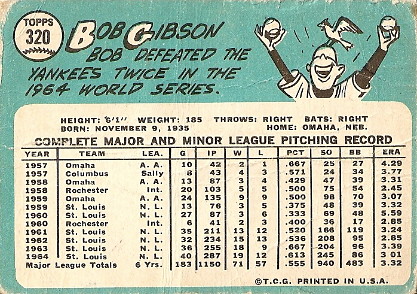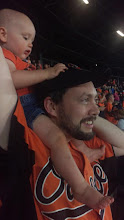
Bob was born Pack Gibson in Omaha, Nebraska. He was named after his father, who died before his son's birth. Despite a childhood in which he endured asthma, rickets, pneumonia, and a heart murmur, the young Gibson became adept at both basketball and baseball. He earned a basketball scholarship to local Creighton University, and after signing with the Cardinals in 1957 (for a $3,000 bonus) he delayed his baseball career to play with the Harlem Globetrotters. It was there that Bob earned the nickname "Bullet". He thrilled fans with his backhanded dunks, but his desire for legitimate competition led him back to baseball.
Bob certainly rose to the top of the National League like a bullet, spending just one season at AAA Omaha before breaking camp in 1959 with St. Louis. After two seasons with mixed results in the majors, the 25-year-old righty showed signs of things to come in 1961 with a 13-12 record, 10 complete games, and a 3.24 ERA. He developed a reputation as a fierce competitor, known for refusing to smile at the ballpark and for brushing back hitters to assert his ownership of home plate. He was surly even with his teammates, forever earning my admiration for telling his catcher Tim McCarver that "the only thing you know about pitching is that you can't hit it".
Gibson's career is almost monotonous in its excellence. He was an eight-time All-Star, and struck out 200 batters nine times. He was always getting better; his win totals increased each year from 1960 to 1966, topping out at 21 (he missed significant time in 1967 with a broken leg). In 13 straight seasons, he completed 10 or more games. Bob dominated in every facet of the game, even winning nine straight Gold Gloves between 1965 and 1973. He was even used as a pinch hitter on occasion; his career average was .206 with 24 home runs and 144 RBI. Bob Lemon was the only other post-World War II pitcher to bat .200 with 20 HR and 100 RBI, and he started out as a third baseman!
Any conversation about Bob Gibson's skills begins and ends with his ridiculous 1968 season. 22 wins, 9 losses. 28 complete games, 13 shutouts. 47 consecutive scoreless innings, and two runs allowed in a span of 92 innings. 198 hits and 62 walks in 304 2/3 innings for an absurd 0.85 WHIP. His 1.12 ERA is a live-ball era record. Toss in 268 strikeouts for good measure, and you have the National League Cy Young Award winner AND Most Valuable Player. 1968 is widely known as the Year of the Pitcher, but you could cut to the chase and call it the Year of Gibson. Major League Baseball lowered the height of the pitching mound the following year to increase offense, and #45 of the Cardinals was a big reason for that.
As fantastic as Gibson was in the regular season, he was on another plane in the World Series. His first postseason exposure came in 1964, and he was immediately up to the task. After faltering in the ninth inning of an 8-3 Game Two loss, he roared back to pick up complete-game wins in Games Five and Seven. For the Series he struck out 31 in 27 innings and took home MVP honors. But Bob's work in 1967 dwarfed the 1964 Fall Classic. Having just returned in early September from a broken leg, he allowed three total Red Sox runs in three complete game victories. 14 hits allowed vs. 26 strikeouts. Two-for-two, MVP-wise. Back for a third World Series in 1968, Gibson put an eye-popping capper on his monster season. In Game One, he struck out 17 Tigers to set a Series record. Game Four was a five-hit, ten-strikeout, 10-1 complete game victory. In Game Seven, Mickey Lolich outdueled him in a 4-1 Tigers win. But Bob added eight more K's to set a World Series record of 35. For his postseason career: 7-2, 8 CG, 1.89 ERA, 92 K/81 IP. Wow.
Gibson kept plugging along into the mid-1970s, but showed signs of weakness at age 38 (11-13, 3.83). The following season (1975), he hit the wall: 3-10, 5.04. His right knee hampered by nearly 4000 innings of wear and tear, he retired with 251 wins, 255 complete games, a 2.91 ERA, and 3,117 strikeouts (he was the first National Leaguer to whiff 3,000). In 1981, he was a first-ballot selection for the Baseball Hall of Fame.
In the 1980s, Bob was a pitching coach for the Mets, Braves, and Cardinals. He's also worked for St. Louis as a special instructor, and never lost his mean streak. During an All-Star Old Timers' Game in 1992, Reggie Jackson hit a home run off of him. In the following year's game, the 57-year-old righthander brushed Jackson back from the plate with a close pitch!
Fun fact: Gibson no-hit the Pirates in 1971, striking out ten batters in an 11-0 laugher. It was the first no-hitter in Three Rivers Stadium, and the first in any Pittsburgh ballpark in more than six decades.



I appreciate the recognition and it was my pleasurable to assist you in reaching your goal! I recommend that you read Bob Gibson's book " Stranger to the Game," a fascinating expose on baseball in the 1960's. Bob, like many black athletes of his time, endured more than just challenges on the diamond; the book gives the insight often not known to the general baseball observer. I was fortunate enough to attend a book signing in which Bob Gibson gave us a reading and answered questions about his book. Bob graciously signed my book as well as many others. I was impressed by the sincerity of his demeanor, and sensed that I was in the presence of a true baseball hero! Thanks for the great work on Bob Gibson, he deserves it!
ReplyDeleteAs a faithful reader I'm not sure how I missed this post until tonight. But I'm glad I saw it. I've always felt fortunate to have been able to see Bob Gibson pitch. He is the best righthander I've ever seen, bar none. I think what made him great was his incredible competitive nature. I saw him at the height of his career (1968) but my best memory of him came in his final season, 1975.
ReplyDeleteMy best friend and I (he's a fanatical Cardinal fan) copped seats right behind the vistors dugout in the Astrodome. Game went to extra innings and the cardinals scored in the top of their half of the 10th(?) 11th(?). Gibson had been warming up and in he came in the bottom of the inning. He proceeded to fan the side and get the save. For that one inning he looked like the Gibson of 1968. I'll never forget his intensity and he came off the mound to the dugout surrounded by his teammates. They were happy and slapping him on the back. He looked fierce. That was a cool night.
Rick and Bob - Thanks! Those are both great first-hand accounts of a true baseball legend. I appreciate you sharing your own perspectives on some of these players.
ReplyDelete